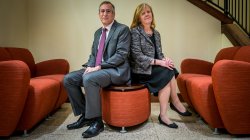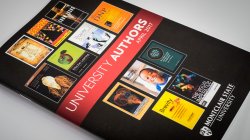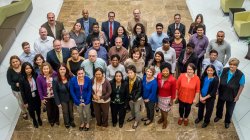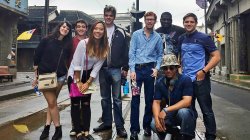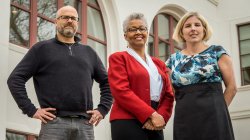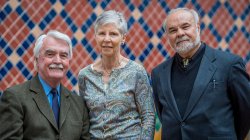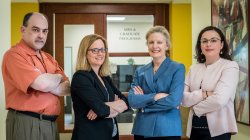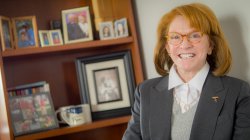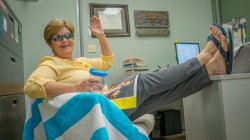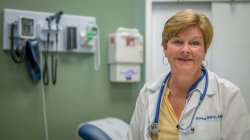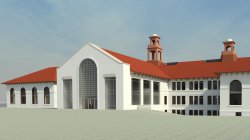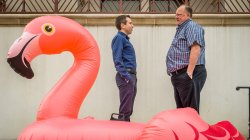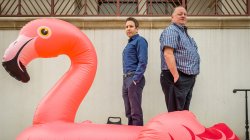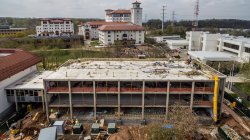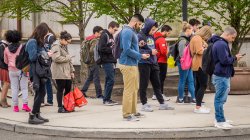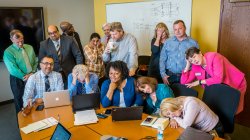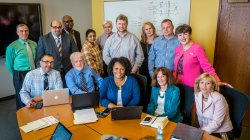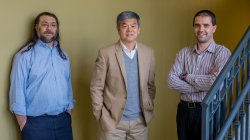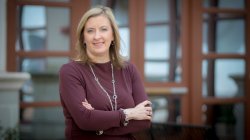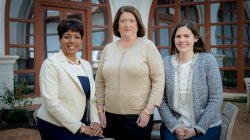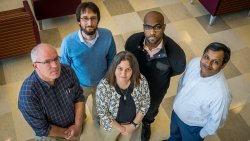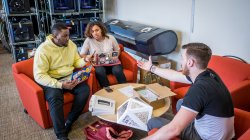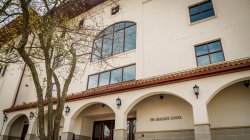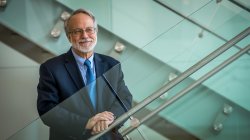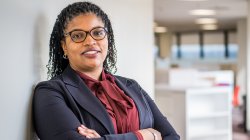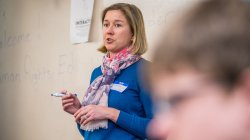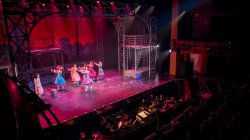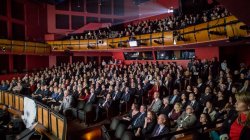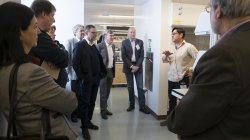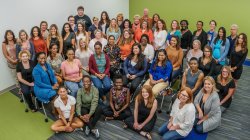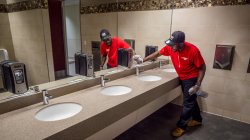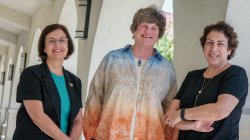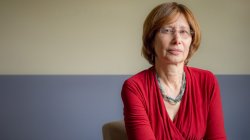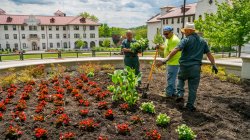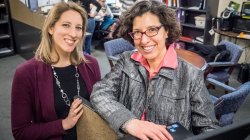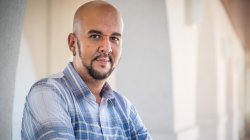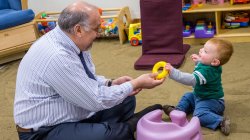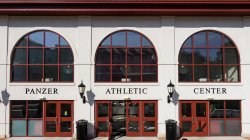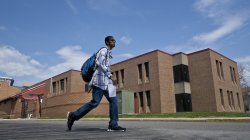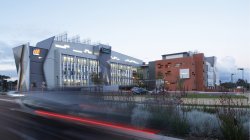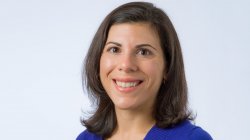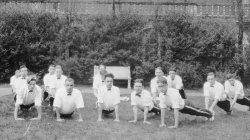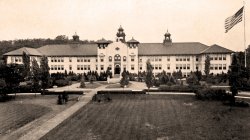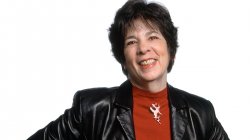President’s Spring Address to the University Community, 2017
April 26, 2017
Posted in: Featured Links, News for Faculty & Staff
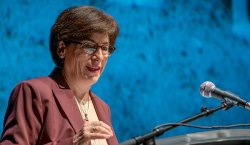
Good afternoon, and welcome to this annual spring address. After 19 years, I am grateful that you all still come. Let me begin with some well-known words by John Donne:
No man is an island,
Entire of itself,
Every man is a piece of the continent,
A part of the main.
If a clod be washed away by the sea,
Europe is the less.
As well as if a promontory were.
As well as if a manor of thy friend’s
Or of thine own were:
Any man’s death diminishes me,
Because I am involved in mankind,
And therefore never send to know for whom the bell tolls;
It tolls for thee.
Hold that thought. The relevance of those words for us and for our times will, I hope, be apparent.
This year has been stunningly busy and productive, and one that has been particularly rich in cross-campus collaborations. Our most significant accomplishment in the area of academic programs was the very successful opening of the University’s new School of Nursing. It was just one year ago when we announced the appointment of Dr. Janice Smolowitz as the founding dean of our proposed School of Nursing. Jan arrived on campus last May, and, a mere four months later, brilliantly inaugurated the School’s first class of 54 highly qualified RN to BSN students and set to work overseeing the final stages of the School of Nursing facility, all the very complex licensure and certification approvals necessary for Nursing programs, brought Dr. Courtney Reinisch on board as Director of Undergraduate Nursing, and, with the help of colleagues from other University programs, recruited two highly qualified new faculty who will be joining us this September. Additional Nursing programs are already well along in preparation, and I expect this new School will offer really strong opportunities for collaboration with the University’s many excellent programs in cognate fields, such as Public Health, Psychology, and others.
Another major programmatic success was the development and approval of the PhD in Clinical Psychology and the preparations for the acceptance of the first class of Psychology doctoral students to begin in September. Professor Jeremy Fox led a large team of faculty and professional staff in development of the program, while Department Chair Ken Sumner made sure that the wheels of the University engine moved forward to get all of the logistics and approvals accomplished. The creation of this doctoral degree achieves a long-held goal of the Psychology Department, and I am sure the department has the capacity to make it a very robust and successful program.
The Feliciano School of Business also achieved a major goal with the launch of a fully online MBA, which currently has 90 students in the program, bringing the number of graduate students in the School of Business to 500. The successful development and implementation of the program was largely the work of Professor Ross Malaga from the Department of Information Management and Business Analytics, Betsey Rosini, Assistant Dean of the Business School, Nicole Koppel, Director of the MBA program, and Jonida Dervishi, the Assistant Director of the MBA program. A number of certificate programs have been developed that can be taken separately or in conjunction with the MBA in areas such as Data Analytics, Human Resource Management and Forensic Accounting.
The College of Humanities and Social Sciences and the Feliciano School of Business have been working together under the leadership of Dean Rob Friedman and Vice Dean Kimberley Hollister to complete the development of a new BA in Language, Culture and Business with an innovative curriculum that integrates the study of foreign language and culture with a strong grounding in business operations. The opportunity here is to create an innovative and highly marketable program that addresses a genuine need in the global economy, combining two distinct disciplinary areas, one with extremely high student demand and one facing enrollment challenges.
In a similar mode, the creative arts and business are blended as a number of students in the College of the Arts, particularly in Art and Design, study the Entrepreneurial Mindset and Innovation at the Feliciano Center for Entrepreneurship in the School of Business. The Center for Entrepreneurship is intent on continuing to expand its outreach to and collaboration with programs across the campus.
Next year will see the full introduction of the Department of Art and Design’s completely re-imagined undergraduate curriculum, which places a heavy emphasis on transdisciplinarity. To accommodate the new curriculum, as soon as the spring term is over, renovation will begin on four instructional spaces in Calcia, transforming them from standard classrooms that are in pretty bad shape into hybrid spaces conducive to a wide range of art and design courses in both traditional and digital media.
Under the leadership of Assistant Dean Tammy Samuels, Career Services Director Linda Flynn, and Director of Academic Advising and Internship Services Rebecca Madson, the College of Education and Human Services opened its Student Success Center this year. With a combination of professional staff and well-prepared graduate assistants from the Higher Education Administration master’s program, the Center, focusing primarily on undergraduate students in the College, provides advising, career planning, and support for internships and clinical experiences. The integration of all services in one location in University Hall supports coordination, coherence, and an equitable array of services to students in all the College of Education and Human Services programs.
The University was particularly active in a number of important projects in service to the external community. Among the many such initiatives, I would note the Montclair State Holocaust, Genocide, and Human Rights Education Project, directed by Professor Zoe Burkholder from Educational Foundations, which, in partnership with the New Jersey Commission on Holocaust Education, sponsored a number of events designed to connect the local history, politics and culture of New Jersey to global human rights education by examining historical subjects such as the Holocaust as well as contemporary human rights issues. One especially noteworthy activity of the project this year has been the creation of a human rights education internship with funding from the Axelrod Family Foundation. Fourteen interns from across the University researched a human rights topic of their choice, including Black Lives Matter, the Syrian refugee crisis, representations of African Americans in the media, LGBTQ civil rights, mass incarceration, Islamaphobia, Muslim feminism and women’s reproductive healthcare. The interns worked alongside Professor Burkholder to prepare and teach lessons and participate in workshops on their topic in local schools and youth groups.
In another new community service initiative consistent with the University’s recent designation as a Hispanic-Serving Institution, the Undergraduate Admissions Office, under the leadership of Jeffrey Indiveri-Gant, developed a program called the Hispanic Student College Institute, which will launch this August for 200 Hispanic high school students. The students will be challenged to think about their educational future and their aspirations through a program that will focus on areas such as career exploration, financial aid literacy, navigating the college search and application process, essay writing and interviewing. More than 300 Hispanic high school students from eight states have already applied to be part of the program.
The College of the Arts is completing its first full year of a mentorship program with the East Orange Schools. The program has sent arts students and faculty to East Orange to provide students there with classes and workshops and has brought students to campus for performances and special events. In a related effort, Professor Lise Raven, from the School of Communication and Media, has been working with East Orange high school students in filmmaking and with their teachers to help them strengthen their curricula.
In addition to community outreach projects, this year saw the advancement of a number of important international initiatives. Among those, we are close to seeing the accomplishment of a major agreement between the Feliciano School of Business and Curtin University in Perth, Australia, for the creation of 2+2 undergraduate and 1+1 graduate programs, targeting students from Asia and Central and South America. The program has the promise to be both very strong academically and quite large, benefiting from Curtin University’s decades of experience serving many thousands of international students and from the comprehensive quality of Montclair State’s programs in the business disciplines.
Culminating years of work, Dr. William Thomas, Director of the University’s New Jersey School of Conservation, has entered into a partnership with the government of Papua New Guinea and the Porgera gold mine, Barrick Niugini Limited (BNL), to create the two largest protected areas in Papua New Guinea that will conserve over 300,000 hectares of high biodiversity wilderness. This initiative is the first such partnership between the Papua New Guinea government and an individual scientist.
The University’s long-standing and rich relationship with the University of Graz in Austria was further enriched by a four-day visit to Montclair State in February by a delegation of six scientists from Graz to explore new research opportunities with faculty from the College of Science and Mathematics and from Psychology. Domenica Dominguez and her team from Global Education provided essential support in facilitating this important visit.
The College of the Arts plans continued development of its growing partnerships with Chinese institutions, including its joint MFA program with East China Normal University, as well as continued work to realize a 2+2 BFA program in Visual Communication with the Shanghai Institute of Technology. As part of its China initiative, both students and faculty from the Shanghai Theatre Academy will be enrolled this summer in film and screenwriting workshops.
The scholarly and research accomplishments of the faculty continue to grow in both distinction and number. A small number of examples from this very impressive body of work include the following:
Pankaj Lal, Associate Professor of Earth and Environmental Studies and Associate Director of the PSEG Institute for Sustainability Studies, received the Presidential Early Career Award for Scientists and Engineers for his work in sustainable bio-economics. Announced by President Obama in January, Professor Lal is one of only 102 recipients nationally for this award which recognizes innovative research at the frontiers of science and technology.
The world premiere of Professor Marcos Balter’s piece, shadows of listening, was performed on April 3 by the Chicago Symphony Orchestra. The piece was commissioned by MusicNOW and received excellent reviews.
Professor Naomi Liebler of the English Department has been awarded the prestigious Townsend Harris Medal by the City College of New York Alumni Association, for outstanding achievement in her chosen profession. She joins an amazingly distinguished group of former awardees.
In an exciting cross-college effort, Professors Erin Krupa and Steven Greenstein of Mathematics, Dr. Jennifer Robinson from the College of Education and Human Services and Diana Aria from the County College of Morris received a $1.4 million multi-year award from the National Science Foundation to better prepare effective elementary school mathematics teachers.
Professor of Physics Marc Favata received the prestigious, five-year, $400,000 National Science Foundation CAREER award for his work in gravitational waves. The number of our faculty who have received this very significant recognition continues to grow, and, in addition to Professor Favata, its latest member, the group includes Professors Stefanie Brachfeld and Pankaj Lal from Earth and Environmental Studies, Professor Jamaal Matthews from Educational Foundations, and Professor Quinn Vega from Biology.
Professors Stefan Robila of Computer Science, David Trubatch of Mathematics, and Charles Du of Biology were awarded a $500,000 National Science Foundation Major Research Instrumentation award to acquire a high-performance computing cluster which will serve faculty from across the campus in a wide range of disciplines.
Professors Jennifer Urban and Miriam Linver co-direct the Research on Evaluation and Developmental Systems Science (REDSS) Lab, which currently has four active grant-funded evaluation projects totaling close to $4 million, including studies of the Boy Scouts of America, the Children’s Hospital of Philadelphia’s Center to Promote Adolescent Health, Character, and Well-Being, The Partnerships for Advancing Character program, and a prominent school-based character development program in Scotland. Professors Urban and Linver are planning to transform the REDSS Lab into a University Research Institute.
Professor Laura Lakusta of Psychology received a $500,000 National Science Foundation award to study interactions between language and cognition in the early acquisition of spatial language.
In just over five years, the Center for Autism and Early Childhood Mental Health, led by Dr. Gerry Costa, has raised more than $7.2 million in grants, gifts and fees to support its mission to meet the needs of infants and young children and their families through theoretical education, research-based methods and clinical applications. The Center was designated by the New Jersey Department of Health in 2012 as the New Jersey Autism Center of Excellence Coordinating Center and, since that time, has received over $3 million to provide support to 25 clinical research projects and five autism medical homes.
And please check out the April 2017 very impressive compendium of University Authors, which, in addition to this year’s many book publications, also includes faculty recordings and exhibition catalogs. You can start compiling your summer reading from work such as Coercive Concern: Nationalism, Liberalism, and the Schooling of Muslim Youth by Professor Reva Jaffe-Walter, or The Sight of Semiramis: Medieval and Early Modern Narratives of the Babylonian Queen by Professor Alison Beringer, or Mexicans on the Move: Migration and Return in Rural Mexico by Professor Frances Rothstein, or The Visual Imperative: Creating a Visual Culture of Data Discovery by Professor Lindy Ryan. Dig in. You will definitely come back from the summer much smarter.
While all these impressive achievements were afoot, the University also marked three important anniversaries this year. Cast your mind back in time. The beginning for us was not the creation of the world. “In the beginning” for us was the creation of the Montclair Normal School in 1908. In 1917, nine years after that momentous event, the Newark Normal School of Physical Education and Hygiene was created. It was later expanded and modestly renamed by its director, Henry Panzer, becoming the Panzer College of Physical Education and Hygiene offering bachelor’s degrees in physical education. Fast forward to 1958 when two important things happened. First, the Montclair Normal School, which had become Montclair State Teachers College, became Montclair State College, dropping “teachers” from its name and achieving recognition as a full liberal arts institution, and, second, a merger was proposed and implemented, blending Panzer College into Montclair State and, in one fell swoop, giving Montclair State a whole range of programs in physical and health education that it had previously lacked. If you are following this history lesson, you will see that this year, therefore, marks the 100th anniversary of the creation of the Newark Normal School that was the origin of the University’s current highly-regarded programs in physical education. I know that the modest Henry Panzer will be pleased, from his grave, to see that his name still endures in the great big sign that proudly announces the University’s Panzer Athletic Center. Since the merger in 1958, these programs have graduated over 3,000 students and are enjoying their current incarnation with over 700 students majoring in undergraduate and graduate degree programs in exercise science, physical education and athletic training.
From a hundred years to 10, this year, we also celebrated the 10th anniversary of the John J. Cali School of Music.
And, finally, created in 1997, this year The Graduate School celebrated its 20th anniversary. The Graduate School was established to provide support and the opportunity for expansion for what had been Montclair State’s historic commitment to graduate study. It is felicitous that, in this anniversary year, we were able, for the first time, to provide The Graduate School with an integrated and handsome location right at the heart of the campus. Over the past seven years, nobody on campus has been more closely associated with the care and nurturing of our graduate programs than Dr. Joan Ficke, the Dean of the School. Dean Ficke has overseen the development of new graduate programs, including just this year, the PhD in Clinical Psychology, the Master of Social Work, the MS in Business Analytics, and the MS in Information Technology. She also played the leadership role in preparing the way for the University’s recent recognition as a research doctoral university by the Carnegie Classification of Institutions of Higher Education. She has re-engaged the work of the Graduate Council, and she has set The Graduate School on the path to further achievement. It is, therefore, with considerable gratitude for her efforts and accomplishments that I announce that Joan has decided to step down from the deanship at the end of the fall 2017 term, and, after a well-earned leave, she will be returning to the faculty in September of 2018 in a joint appointment in the Departments of Public Health, and Exercise Science and Physical Education. Thank you, Joan, for your many accomplishments.
One of the major activities of the year was the University community’s successful completion of the multi-year Middle States Reaccreditation Process. The final Commission report will not be delivered until summer; however, the exit interview with the visiting team suggests that the report will be an extremely positive one. The Middle States review is an arduous undertaking, and it involved the contributions of many people from throughout the campus, but I particularly want to recognize the leadership of Provost Gingerich and the excellent work provided by the project leaders, Associate Provost Joanne Cotè-Bonano, Professor and Acting Director of the School of Communication and Media, Christine Lemesianou, and Professor Joan Besing of Communication Sciences and Disorders. They did an extraordinary job coordinating this very complex task.
It may not sound as inspiring as all the academic accomplishments, but on the administrative side of the house, we were all ecstatic that the Finance Division closed the University’s fiscal year books for the first time in the new PeopleSoft FMS environment and completed a successful external audit with unqualified findings. We thought it was thrilling that, after yet another credit review, Moody’s and Fitch reaffirmed the University’s strong A2 and A- bond ratings, respectively. We were tickled downright pink that, the Finance team, under Vice President Jon Rosenhein’s steady leadership, refinanced the University’s outstanding bonds, generating $23 million of present value savings, implemented the student accounts function of the new Banner system, successfully billed well over $220 million in tuition and fees, and, working with Student Development, decreased significantly the de-registration of students for unpaid balances through counseling, financial assistance and improved communications. In conjunction with the Office of Budget and Planning, and Information Technology, the Finance Division also developed a new financial tool that will make the reporting responsibilities of principal investigators on grants much easier. And, in another step to improve post-award services, the grants accounting team was relocated and will now be directly adjacent to the Office of Research and Sponsored Programs, which, under the terrific leadership of Ted Russo, will be able to provide grant recipients with more integrated services.
In a really complex undertaking, the offices of University Facilities, Budget and Planning, Finance, Human Resources, and University Advancement moved mid-year from their offices in College Hall and 855 Valley Road to a newly designed 50,000-square-foot, open-plan space in the Overlook building where, in fact, they are overlooking the campus and the rest of us while they oversee the vast administrative operations of the University. This move constitutes the University’s first major foothold in this building which is contiguous to and highly visible from our campus.
Although we are still working out quite a few kinks, OneMontclair, the integrated new computing infrastructure on campus, has, in fact moved much closer to full implementation this year. NEST has become an integral part of student life. Responding to students’ request for smartphone compatibility, NEST Mobile was launched in January. In a few short months since, more than one-third of the student population is using NEST Mobile to access their class schedules, important notifications, campus news, events calendars, dining venues, computer labs, the Student Rec Center, and a GPS campus map, and more features will continue to be rolled out.
The new Workday system was launched, providing tools to manage employee records and payroll, self-service capabilities, and improving access to employee and organizational information. The new campus-wide wireless network was launched, improving network access, streamlining registration of new devices, and enhancing network security, and the rollout of Gmail across all faculty and staff was completed, enabling enhanced email and reducing support requirements.
This work will continue into next year, enhancing our access to and utilization of information and streamlining access to systems. Continued patience will be required for a while yet. There is not a single campus in the nation that has effected the type of technology transformation we have undertaken without, in most cases, a good deal more grief than we have encountered. We are getting there, and I am very grateful to Vice President Candy Fleming, Associate Vice Presidents Samir Bakane, Donna Sadlon, and Kathy Ragan, and the entire Information Technology team and the Team Leads in the campus divisions and all of their teams for their persistent efforts in moving us toward that computer-generated light at the end of a long tunnel. It has been a genuine “good grief” endeavor, but we have been fortunate in the many hands pulling relentlessly at the oars of progress.
Construction is nearing completion on the School of Communication and Media. With some studios and control rooms already in use, the building, which will be fully operational in June, will provide 105,000 square feet of production, post-production and screening facilities, with the extensive use of leading-edge technology designed and implemented by the Sony Corporation, which is the University’s strategic technology partner. September will bring a formal opening ceremony for the new facility.
The renovation of Mallory Hall will be in full swing next year. With completion anticipated by summer of 2018 and occupancy for fall 2018, this $22.2 million project will provide ideal new spaces for the rapidly growing instructional and research programs in Computer Science and Information Technology, as well as other College of Science and Mathematics programs and services. This half century old building will expand to 43,800 GSF, including a new 4th floor, and will have a new exterior to match the elegant mission style of Schmidt Hall, its original sister building. The project will add classrooms and laboratories, faculty offices, meeting rooms and student study spaces, and many specialized spaces for research in areas such as image processing and systems, parallel computing, computational sensing, and optics.
This summer we will continue the process of emptying out College Hall in preparation for its complete renovation as an integrated student services center. If you are looking for the President’s office, for the next couple of years, you will find it in the Feliciano School of Business, and the Provost and his team will be camping out with the School of Nursing and The Graduate School in their newly renovated building. College Hall which was the original building of the Montclair Normal School, built in 1908, has seen many adjustments in use over the past 109 years. It is a large and durable building, but long overdue for its 100-year makeover. Over a two-and-a-half year period, this historic building will have a complete life-cycle renovation of all its infrastructure and utility systems and dramatic and architecturally sensitive improvements to all of its spaces to create a completely reimagined building that will house all the student services, including admissions, advising, registration, financial aid, student accounts, disability services, tutorial services and many others. The relevant staff in student development, academic affairs and finance have already begun the process of rethinking how they can better integrate and provide their services, making innovative use of technology, cross-training, and the types of spaces the renovated building will provide. The end result will be a central point for students on the campus and another century of vital life for this iconic and historic campus building.
This summer, you will notice the precursor to the College Hall project. The University’s current IT vault and connecting infrastructure, which is located in College Hall, is at maximum capacity and limiting the University’s ability to expand its technological services. So, this July, construction will begin on an entirely new Information Technology central vault, including expansive underground infrastructure improvements.
All these big system and construction projects on the campus easily capture our attention, but I want to take a moment to call your thoughts to the hardworking University Facilities team that, every day of the year, in good weather and bad, from crack of dawn and often through the night, keeps this campus clean and in good repair, including 435,000 man and woman hours of strenuous cleaning and 52,000 people hours maintaining the grounds. People often comment to me about how clean and beautiful this campus is, and I can promise you that it does not get that way by itself, so, how about a big cheer for the men and women of University Facilities.
And, finally, in regard to the year’s activities, the Annual Scholarship Dinner took place on March 4, and the focus this year was on all the science and health-related programs in the University. Here is part of the video that the attendees saw:
The video, together with the program participants and awardees, including Lt. Gov. Kim Guadagno; Dr. Giovanni Caforio, the CEO of Bristol-Myers Squibb; Annette Catino, the president of QualCare Alliance Networks; Judi Schumacher-Tilton, the president of the Schumacher Chevrolet Auto Group; and Steve Adubato, an anchor on PBS and NJTV, and really fine work done by the whole team from University Advancement, led by Vice President Jack Shannon, resulted in the most successful dinner we have ever had, raising approximately $800,000 for scholarships. As always, the College of the Arts contributed their talents to the effort, and this year the programs of Theater and Dance and the Cali School of Music performed selections from their spectacular production of West Side Story, which left the audience literally astounded.
This might be a good place to note that the telegenic star of the dinner video, the Dean of the College of Science and Mathematics, Bob Prezant, as most of you know, will be leaving us to take up the position of provost of Southern Connecticut State University. Bob has overseen enormous growth and development in the instructional and research programs in science and mathematics and in the acquisition of improved facilities, equipment, funding and important relationships for the College. He has also been a great advocate for the University and a terrific colleague for many people on campus, including me. Bob, we wish you well in your new position, but you may not take any of your faculty, buildings, or mass spectrometers with you when you go.
In regard to departures, there are a number of long-serving faculty who are retiring this year, and among them are many whose careers here defined the campus community in many important ways. Among them are:
Professor Rolf Sternberg who, after 46 years at the University, retired this past January. Rolf was an esteemed scholar in Latin and South American geography with a focus on hydroelectric projects in Brazil. Professor Gregory Waters, retiring after 33 years, served most recently as Director of the Honors Program, and prior to that in the Provost’s Office, in University Advancement, and even, for a brief time, as Acting President of the University. Professor Larry Schwartz, retiring after 47 years, was for many years the chair of the English Department. Professor Mary Call is retiring from the Linguistics Department after 30 years of service. Among her many achievements, Mary was the recipient of two Fulbright Fellowships. And Professor Vincenzo Bollettino will retire after 48 years from the Spanish and Italian program where he worked in the area of contemporary Latin American literature.
Associate Dean of the College of Education and Human Services, Kim O’Halloran, is leaving Montclair State to take up a position as Associate Provost for Graduate Education at Widener University. We wish her good fortune as she continues her career and thank her for her many contributions to Montclair State over the years.
Donna Barry has been the Director of the University Health Center since 1999. During her time in the position, she shaped the Center into a highly professional health care provider, serving about 11,000 patient visits a year. Fifteen years ago, and well in advance of national attention to the issue of sexual assault on campuses in the nation, Donna Barry developed the concept of a campus Sexual Assault Response Team and, in collaboration with Chief of Police Paul Cell, created one of the first campus forensic teams in the nation. Donna was an ambassador from this University, serving as a member of the NJ-1 Disaster Medical Assistance Team, providing services on the ground in Haiti, New Orleans and other disaster areas. Donna Barry will be leaving the University and New Jersey and will take up the position of Director of Health Services for the Ross University School of Veterinary Medicine, which just happens to be on the island of St. Kitts in the Caribbean. She has been an extraordinary colleague, and I suppose she has earned her time in the sun.
We have some arrivals as well. This past March, Junea Williams-Edmund took over as Acting Vice President for Human Resources. Junea joined Montclair State in October of 2015 as Assistant Vice President for Compliance and Organizational Effectiveness, coming from her position at Columbia University. Junea received her B.A. in History from Barnard College and her J.D. from New York University School of Law. I am grateful to her for stepping up to serve as Acting Vice President during this dynamic and complex time, and she has a great team in Human Resources to support the work of that important division.
I mentioned earlier Dean Prezant’s impending departure, and I am pleased that Professor Lora Billings has agreed to serve as Acting Dean of the College of Science and Mathematics effective this summer. Professor Billings is a member of the Department of Mathematical Sciences. She is an extremely accomplished scholar in applied mathematics, with a distinguished publication record, over $2 million in federal research funding, and she returns to us from having served a term as the program director for Applied Mathematics at the National Science Foundation.
The University will be undertaking three national searches to fill the positions of Vice President for Human Resources, Dean of the College of Science and Mathematics, and, because of the tremendous increase in the University’s engagement in research and continuing success in garnering external research support, a new combined position of Associate Provost for Research and Dean of The Graduate School.
So, here we are, approaching the end of yet another amazing academic year, and we do so in a time of considerable turbulence and confusion in the world beyond the boundaries of this campus. Like our sister universities throughout the nation, we awake each day to a world in which the search for truth seems to have become subversive, in which facts can be discarded in the face of alternative facts, in which science is suspect and scientists treated as though they were magicians, presenting illusions by sleight of hand. As a country, we appear no longer to hold the founding truths of the nation as self-evident. We appear as a country able to look at a child and think it reasonable to ask if she is documented, instead of asking if she is hungry or healthy or cared for or in need of education. What could it possibly mean for one human being to document another?
We are all diminished by the loss of any one of us, and so we must try not to lose each other. And we must try to be worthy of each other. When we look around this room, what each of us should see is all those who are relying on us. It’s nice if we like each other, but it is not necessary and it’s not the point. The point is the greater good.
This University is the world in which we have chosen to work, and we do so for our students, we do so to repair the world, and we do so to protect earth.
No man is an island
Entire of itself…
Any man’s death diminishes me
Because I am involved in mankind…
When we leave this place, the bells in College Hall will be ringing. Do not send to ask for whom those bells toll. I will tell you. They toll for us, not mournfully, but in hope, reminding us of the chance we have to make a difference for the greater good, if we just remember to seek the best in ourselves and in others. Thank you all for your extraordinary work this year. Let’s bring this academic year successfully to a smooth landing, so we can re-fuel and get this space ship ready to take off again.
Thank you.
Attached Media
Click on an image below to enlarge photo.

